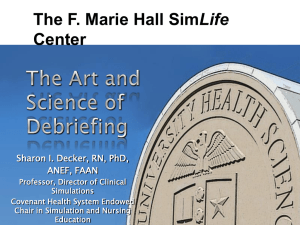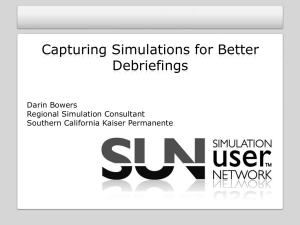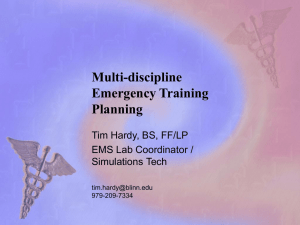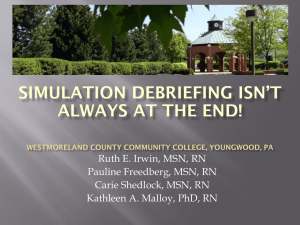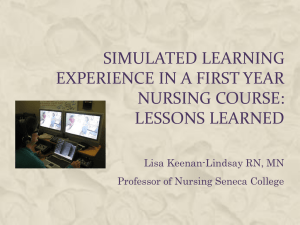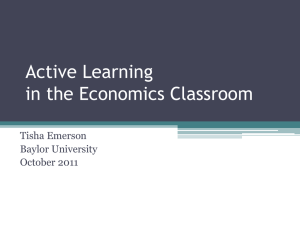Debriefing
advertisement
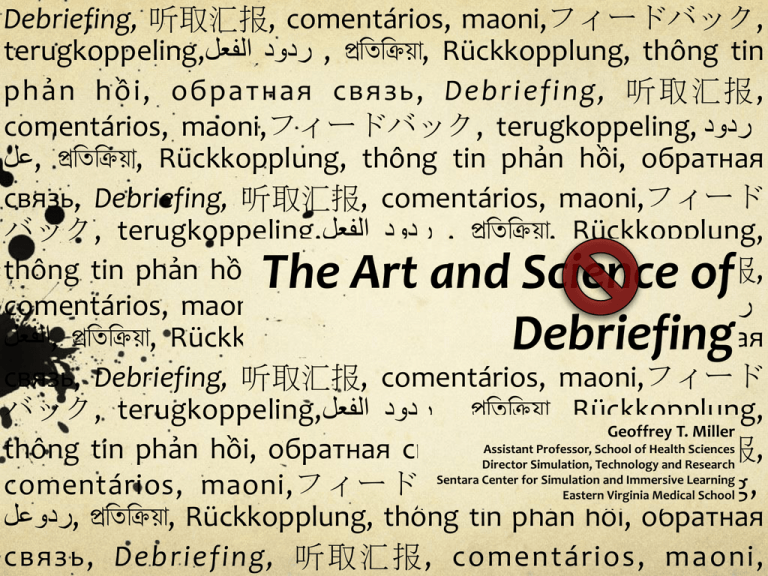
Debriefing, 听取汇报, comentários, maoni,フィードバック, terugkoppeling, ردود الفعل, প্রতিতিয়া, Rückkopplung, thông tin phản hồi, обратная связь, Debriefing, 听取汇报, comentários, maoni,フィードバック, terugkoppeling, ردود عل, প্রতিতিয়া, Rückkopplung, thông tin phản hồi, обратная связь, Debriefing, 听取汇报, comentários, maoni,フィード バック, terugkoppeling, ردود الفعل, প্রতিতিয়া, Rückkopplung, thông tin phản hồi, обратная связь, Debriefing, 听取汇报, comentários, maoni,フィードバック, terugkoppeling, ردود الفعل, প্রতিতিয়া, Rückkopplung, thông tin phản hồi, обратная связь, Debriefing, 听取汇报, comentários, maoni,フィード バック, terugkoppeling, ردود الفعل, প্রতিতিয়া, Rückkopplung, Geoffrey T. Miller Assistant Professor, School of Health Sciences thông tin phản hồi, обратная связь, Director Debriefing, 听取汇报, Simulation, Technology and Research Sentara Center for Simulation and Immersive Learning comentários, maoni,フィードバック, terugkoppeling, Eastern Virginia Medical School ردوعل, প্রতিতিয়া, Rückkopplung, thông tin phản hồi, обратная связь, Debriefing, 听取汇报, comentários, maoni, The Art and Science of Debriefing Bottom line, up front… Debriefing is an art form… One which is honed through repeated practice, and experience… There are many approaches and techniques… And very few absolute rules Sessions aims Identify the goals of debriefing. Discuss the elements of debriefing that improve outcomes. Identify various approaches to debriefing. Discuss the process of debriefing. Human processing in action… ARE YOU NO HAPPY? CHANGE SOMETHING YES DO YOU WANT TO BE HAPPY? KEEP DOING WHATEVER YOU’RE DOING YES NO Human processing Natural order of human processing Reflect on it Experience an event Discuss it with others Learn & modify behaviors based on the experience Why feedback/debriefing matters… B C D A A = Education A B = Things you know C = Things you know you don’t know A D = Things you don’t know, you don’t know Feedback… Debriefing… isn’t it all just the same thing? Feedback Feedback comprises a wide array of informational inputs, which may occur prior to, during, and after an experience Feedback is the most important feature of simulation-based learning Knowledge of performance results - key to learning Appears to slow the decay of acquired skills Allows for self-assessment Issenberg SB,McGaghie WC, Petrusa ER, Gordon D, Scalese RJ (2005). Features and uses of high-fidelity medical simulations that lead to effective learning: a BEME systematic review. Medical Teacher 27(1): 10–28. Feedback sources Pre-briefings, instructions, in-case sources, debriefings, peers(team members), log files [manikin, computer, etc], standardized checklists, rating forms, evaluators (faculty, peer, patient), recordings (video)… The KEY is to use multiple sources of feedback… share them with the learner Develop a plan for feedback that supports the individual and/or team learning goals Debriefing • A deliberative, learner-centric process designed to standardize the instructor/student post-event interaction to assist learners in thinking about: • What they did, • When they did it, • How they did it, • Why they did it and • How they can improve. Factors influencing debriefing Objective of the experiential exercise Complexity of the scenario Experience level of participants Experience level of participants with simulation environment Time available for the session The role of the simulation in the overall curriculum Individual personalities and relationships, if any, between the participants Debriefing myths… and realities Debriefing myths… “There is a highly defined process or method for conducting learner debriefing” Realities… “there are surprisingly few papers in the peer-reviewed literature to illustrate how to debrief, how to teach or learn to debrief, what methods of debriefing exist and how effective they are at achieving learning objectives and goals” Fanning, RM, Gaba, DM. The Role of Debriefing in Simulation-Based Learning. Simulation in Healthcare. Vol. 2, No. 1, Spring 2007. Debriefing myths… “The most effective facilitation is achieved when the learners or participants do all of the talking… not the instructor” Realities… Some learners or learner groups may lack an adequate understanding of the event and it’s elements, or posses enough prior learning and experience to effectively reflect and learn. Debriefing myths… “Debriefings should always be conducted in a separate space or environment” Debriefing myths… “Debriefings should always be held after the simulation ” Realities… “in certain circumstances (teaching a technical skill, fatal errors, or seriously flawed behaviors), debriefing may need to occur during the simulation (AKA: in- scenario debriefing)” Debriefing considerations The ultimate failure of debriefing “Learners are left with the mistaken impression that they are doing just fine” “Ignorance more frequently begets confidence than does knowledge” Charles Darwin – The Descent of Man (1871) Identifying & closing the gaps Observable performance Performed well Performance perception Feels good Performed well Feels bad Performed poor Feels poor Performed poor Feels good Knowledge Skill Behavioral GAP Simulation-debriefing relationship Activated Stressed Upset Nervous Tense Excited Alert Elated Happy Simulation Debriefing Unpleasant Bored Sad Fatigued Depressed Pleasant Relaxed Serene Content Calm Inactivated Coaching, prompting & cueing Coaching Directing, instructing and training a person or group of people, with the aim to achieve some goal or develop specific skills Instruction Prompting To move to action Cueing Giving verbal or non-verbal triggers/clues for an action to be carried out at a specific time Facilitation Debriefing ‘Dose’ Debriefing Amount/Time “Debriefing Amount / Time will decrease with higher learner expertise, It will not reach zero” Learner Expertise Novice Expert Lots of debriefing modes Private bedside debrief by facilitator immediately post scenario Private ‘debriefing room’ debrief by facilitator immediately post-scenario Debrief by peers outside of simulation suite Self-guided reflection of video performance Feedback, debriefing & deliberate practice Sim Prep Sim Change Debrief Prep Change Debrief Sim Prep Change Debrief Ericsson’s Model of Deliberate Practice: “Practice does not make perfect… practice makes permanent” Ericsson, KA. (2004). Deliberate practice and the acquisition and maintenance of expert performance in medicine and related domains. Academic Med. 79(10 Supplement):S70-81. Important debriefing points/skills Be genuine and student centric Ask open not closed ended questions: DON’T- Did you have a good experience? DO- Tell me about your experience. Use pauses and silences to elicit feedback Use probing inquiry to gain deeper understanding Perspective on use of video Use if necessary; typically to observe specific events or processes Have participants compare their memory with the recording- “Tell me what happened” Peer input can be inappropriate- facilitator needs to guide the discussion into positive channel Debriefing Models Structured & supported debriefing (SSD) Developed in collaboration with American Heart Association Definition of ‘structured and supported’ Structured elements include three specific debriefing phases with related goals, actions, and time estimates. Supported elements include both interpersonal support as well as use of protocols, algorithms, and best evidence to inform debriefing statements/questions Other considerations Simple, can be learned rapidly, scalable, validated by practice Adapted from: O’Donnell, J.M., Rodgers, D.L., Lee, W, W., Edelson, D. P., Haag, J., Hamilton, M. F., Hoadley, T., McCullough, A., Meeks, R., (2009), Structured and Supported Debriefing [Computer Software]. American Heart Association, Dallas, TX. GAS Model Goal: Actions: GATHER Listen to participants Request narrative from team leader to understand what they think & how they feel Request clarifying or supplemental information from team 25% Sample Questions: All: “How do you feel?” Team Leader: “Can you tell us what happened?” Team members: “Can you add to the account?” GAS Model Actions: Sample Questions: Facilitate reflection on & analysis of actions Review accurate record of events “Tell me more about…” ANALYZE Goal: Report observations (correct & incorrect steps) Reveal participants’ thinking processes 50% Reflect on performance Assure continuous focus on session objectives “What were you thinking when…” “I understand, however, tell me about “X” aspect of the scenario…” “Let’s refocus… what’s important is not who is right but what is right for the patient…” GAS Model Actions: Sample Questions: Facilitate identification & review of lessons learned Participants identify positive aspects of team or individual behaviors & behaviors that require change “List two actions or events that you felt were effective or well done” SUMMARIZE Goal: Summary of comments or statements 25% “Describe two areas that you think you/team need to work on…” Plus- Delta A student-centric approach simulation debriefing using a 2 X 2 matrix. Designed to rapidly gain participant feedback on both instructor and participant performance Debriefing With ‘Good Judgment’ Trainee ‘Frames’ Approach A frame is the internal trainee environment Frames to Actions to Results Perceptions, knowledge, assumptions, feelings, training etc…. Instructor role- ‘cognitive detective’ Tries to figure out frames through using a ‘stance of curiosity’ Genuinely curious inquiry Advocacy and Inquiry model Rudolph, J.W. et al., Debriefing with good judgment: combining rigorous feedback with genuine inquiry. Anesthesiol Clin 25 (2), 361-376 (2007). “Phased-domain” debriefing Teamoriented simulation GROUP Teamoriented debriefing Domainoriented debriefing MD Domainoriented debriefing RN Domainoriented debriefing SA GROUP Summary A few final thoughts… New role for debriefing? To learn the skills to recognize ones own “limitations” (also described by some as incompetence) “To have such knowledge would already be to remedy a good portion of the offense” (Miller, WI. 1993) A possible future… Debriefing and feedback become normative processes encompassing all levels, domains and professional identities of the healthcare system A final note… Any simulation activity is a “snapshot-in-time”, It is reflective of the performance and behaviors which occurred during that specific time interval, It is not a positive or negative predictor of future performance Summary Simulation-based learning activities are supported by instruction (coaching) and facilitation (prompting and cueing) Consider the types of feedback available, and employ those best suited to achieve the desired outcomes Formulate a plan to provide structured debriefing following simulation activities Debriefing should be learner-centric and conducted within a safe environment Participants need and value the feedback Debriefing points are derived through setting appropriate session/ course objectives Questions and discussion For additional information… Geoffrey T. Miller Assistant Professor, School of Health Sciences Director Simulation, Technology and Research Sentara Center for Simulation and Immersive Learning Eastern Virginia Medical School Millergt@evms.edu
